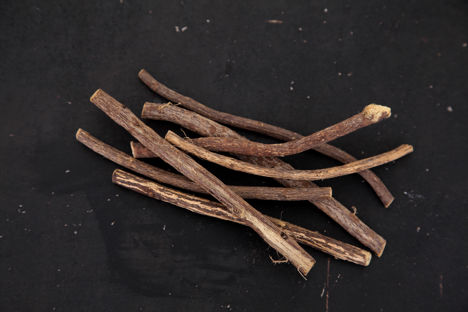Most people's immediate association with liquorice is of Bassetts' Allsorts or Black Jacks, but liquorice root makes a sophisticated cooking ingredient, with an elegant, herbal taste and notes of anise and fennel. Liquorice works just as well in savoury dishes as it does in sweet.
Liquorice root is an ancient ingredient, widely believed to have medical properties. It is appears in historical documents worldwide, from early Chinese medicine to Ancient Egypt. Liquorice is still used as an ingredient in the popular Middle Eastern drink erk-soos, supposed to settle the stomach, and is re-emerging as a popular ingredient with mainstream tea companies, thanks to its soothing qualities.
What to look for when buying liquorice
Liquorice can be bought as a woody root, or as a finely-ground powder, referred to as jethimadh powder in Indian cuisine and liquorice compound in a molecular context. Beware, sweet recipes will occasionally ask for soft liquorice sticks — referring to the shiny black confectionery which has been sweetened and processed.
Liquorice root is a rare sight, but can be found in specialist shops. Ground powders, compounds and teas are a lot more common, often stocked in high street health shops, and speciality ingredient shops.
How to cook with liquorice
Hard and woody liquorice roots impart most flavour when steeped in hot liquid. So teas, syrups, sauces and custards can be infused with the distinctive anise notes by adding the root, heating, and then removing before serving. Increase the intensity of the flavour by adding more roots, or lengthening the amount of time that the roots are steeped in the liquid.
Liquorice roots still give off strong aromas without needing to be heated. Like vanilla pods, they can be used to flavour sugar, and like dried juniper berries, they can be used to liven up salt cures.
Powdered liquorice, or liquorice compound, can be added straight to recipes — whether that's a pinch mixed into a meat rub, stirred into cake batter or added to a sweet custard.
What liquorice goes with
Liquorice's anise flavours feature in a Chinese Five Spice, so cooks should keep that in their mind when using it in savoury dishes. Game like pigeon, quail or duck are all good partners, as is pork. Bitter-herbal juniper notes are also a close fit with liquorice flavours, as Pascal Aussignac demonstrates in his cod recipe, pairing a liquorice sabayon with juniper ashes.
In a sweet context, liquorice is such a big flavour that it works well as a starring ingredient, against a neutral background, as with Christoffer Hruskova's Liquorice ice cream recipe or James Mackenzie's Panna cotta recipe. Liquorice is also a good fit with other big, flavours like ginger and mint, rhubarb and raspberries.
Get in touch
Please sign in or register to send a comment to Great British Chefs.



